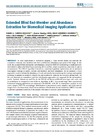Identificador persistente para citar o vincular este elemento:
http://hdl.handle.net/10553/69248
| Título: | Extended Blind End-Member and Abundance Extraction for Biomedical Imaging Applications | Autores/as: | Campos-Delgado, Daniel U. Gutierrez-Navarro, Omar Rico-Jimenez, Jose J. Duran-Sierra, Elvis Fabelo Gómez, Himar Antonio Ortega Sarmiento, Samuel Marrero Callicó, Gustavo Iván Jo, Javier A. |
Clasificación UNESCO: | 3314 Tecnología médica | Palabras clave: | Blind linear unmixing Constrained optimization Fluorescence lifetime imaging microscopy Hyperspectral imaging Optical coherence tomography |
Fecha de publicación: | 2019 | Proyectos: | Identificación Hiperespectral de Tumores Cerebrales (Ithaca) | Publicación seriada: | IEEE Access | Resumen: | In some applications of biomedical imaging, a linear mixture model can represent the constitutive elements (end-members) and their contributions (abundances) per pixel of the image. In this work, the extended blind end-member and abundance extraction (EBEAE) methodology is mathematically formulated to address the blind linear unmixing (BLU) problem subject to positivity constraints in optical measurements. The EBEAE algorithm is based on a constrained quadratic optimization and an alternated least-squares strategy to jointly estimate end-members and their abundances. In our proposal, a local approach is used to estimate the abundances of each end-member by maximizing their entropy, and a global technique is adopted to iteratively identify the end-members by reducing the similarity among them. All the cost functions are normalized, and four initialization approaches are suggested for the end-members matrix. Synthetic datasets are used first for the EBEAE validation at different noise types and levels, and its performance is compared to state-of-the-art algorithms in BLU. In a second stage, three experimental biomedical imaging applications are addressed with EBEAE: M-FLIM for chemometric analysis in oral cavity samples, OCT for macrophages identification in post-mortem artery samples, and hyper-spectral images for in-vivo brain tissue classification and tumor identification. In our evaluations, EBEAE was able to provide a quantitative analysis of the samples with none or minimal a priori information. | URI: | http://hdl.handle.net/10553/69248 | ISSN: | 2169-3536 | DOI: | 10.1109/ACCESS.2019.2958985 | Fuente: | IEEE Access [ISSN 2169-3536], v. 7, p. 178539 - 178552 |
| Colección: | Artículos |
Citas SCOPUSTM
25
actualizado el 30-mar-2025
Citas de WEB OF SCIENCETM
Citations
14
actualizado el 30-mar-2025
Visitas
73
actualizado el 30-dic-2023
Descargas
128
actualizado el 30-dic-2023
Google ScholarTM
Verifica
Altmetric
Comparte
Exporta metadatos
Los elementos en ULPGC accedaCRIS están protegidos por derechos de autor con todos los derechos reservados, a menos que se indique lo contrario.
